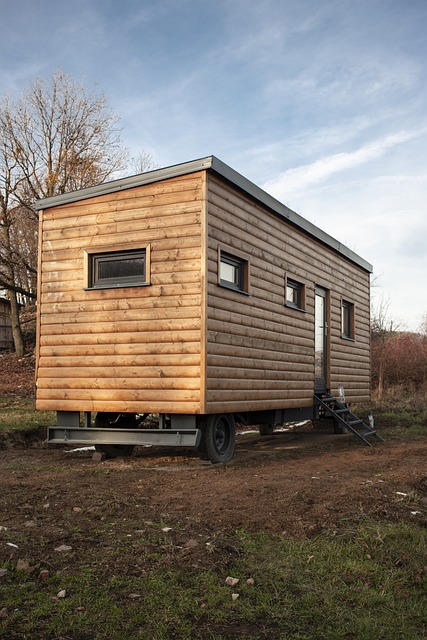
In recent years, both the Tiny House movement and the long-term RV lifestyle have exploded in popularity, and for good reason. We live in a society where working and middle-class wages have stagnated for decades, the cost of owning a traditional home has skyrocketed, and consumerism is seemingly on the rise. Fortunately, we also live in an era where near-universal internet accessibility has enabled a variety of remote work opportunities, making it possible to earn a living while on-the-go.
What is a Tiny Home?
A tiny house, or tiny home, is a miniaturized home with some mobile capabilities. They are usually built on a van or trailer chassis and are designed for towing. They are often built to aesthetically, and even structurally, resemble their larger, traditional counterparts. Most tiny houses are full-featured, with toilet, shower, kitchen, and sleeping facilities. There are no set-in-stone size guidelines for what constitutes a “tiny house,” but the community seems to generally regard the cutoff at 500 square feet.
RVs, by contrast, come in a much wider variety of styles, shapes, sizes, and facility offerings – with many RV models built larger and with more luxurious interiors than comparable “Tiny Homes.” Long-term RVers typically purchase or rent models that come with a toilet, shower, kitchen, and sleeping facilities (or that can be outfitted to include such facilities).
If you’re new to the tiny home movement and the RV community, you may be feeling somewhat lost. At first glance, both options – a tiny home and an RV – seem quite similar, functionally speaking. There are several noteworthy differences worth considering, however.
Significant Differences
Legal and Tax Concerns
RVs are fairly well-regulated, thanks to many decades of mainstream use and social familiarity. When you live in an RV long-term, it’s therefore quite simple to become apprised of the relevant laws that affect you. You can easily determine whether – in a given jurisdiction – your RV will expose you to property tax, for example, or whether you will be able to take advantage of a legal exception.
Tiny homes currently occupy something of a gray area when it comes to applicable tax regulation. In fact, there seems to be a consensus among many in the tiny home community that the “mobility” built into their homes is, in fact, a circuitous method for avoiding property tax. Because the law is not quite clear on whether tiny homes qualify for the same exceptions as RVs, you may be found liable for violating local, state, and/or federal law if you’re not careful.
Mobility and Versatility
Tiny homes are heavy, unwieldy, and less aerodynamic than RVs. They are mobile, but in the most limited sense – in other words, they can be moved from location to location, but doing so is rather difficult. Certainly, setting up a tiny home in a wilderness area is either impossible or a significant hassle. As such, living in a tiny home generally leads to less practical freedom than many initially expect.
By contrast, RVs are designed to be frequently moved and there is substantial RV infrastructure to encourage such movement. There are RV campgrounds dotting the North American landscape, and some public park networks allow for long-term boondocking with your RV. In practical terms, RVs provide a great deal more mobility and locational versatility than tiny homes.
Customizability
Tiny homes are rarely standardized and are often built according to the buyer’s specifications (within reasonable bounds, of course). As a result, they tend to be more customizable than RVs. This excessive customizability is both a negative and a positive, however. Though your tiny home can be built to suit your particular needs, building one from scratch can take several months, and if you make too many specific customization requests, you may find that the home isn’t quite up to par with expectations.
By contrast, the RV industry is expansive and includes trusted manufacturers that have been in the business for over half a century. As such, many popular RV lines are battle-tested over several decades. This standardization leads to a higher baseline level of quality.
Comfortability
Though many people assume that a tiny house would be inherently more comfortable than an RV, the landscape of RVs has changed quite substantially in recent years. In many cases, you can find an RV that is more spacious and comfortable than a custom-built tiny home.
- Large-scale RVs have greater square footage than most tiny homes.
- Some RV models have integrated high-end materials with slideouts to expand the spaciousness of the interior.
- Luxury RVs often feature modern styling and high-quality materials (such as authentic wood paneling and furniture).
Ease of Maintenance and Repairs
RVs are not simple to repair and may require a visit to a specialized RV repair shop if you run into mechanical issues, but their ubiquity on the road means that you’ll have easy access to specialized support wherever you go.
By contrast, tiny home construction is even more nonstandard, and they are still quite a bit less popular than RVs. As such, you may have more trouble finding adequate repair support when you encounter mechanical issues with your tiny home.
The recent popularity of both the Tiny House movement and the long-term RV lifestyle is – in large part – driven by the confluence of these many factors. More and more people want to downsize and simplify their lives. They want to live in comfort, but they don’t want their lives to be governed by the inevitable accumulation of material “things.” The choice to live long-term in an RV, or to move into a tiny home, is an attempt by some to take more control of their life during a broader societal shift towards heightened consumerism and higher cost of living.
